Have you ever wondered how to find a reversal without a technical indicator? Is it possible? What’s the trick to it? No trick, actually.
This article will explain how Candlestick Patterns reveal reversals like no other technique.
Candlestick patterns are reversal patterns in price action formed when the market pushes prices to Overbought or Oversold levels. These patterns are used to identify reversal points in Rallies and Selloffs.
You can take advantage of these patterns for profitable trading if you understand their basics and how to use them with other technical analysis tools and techniques.
What is the Definition of a Candlestick?
So what makes up a candlestick?
A candlestick comprises a body (open/close) and shadows (high/low).
A shadow can also be referred to as a wick.
You will want to notice each candlestick component because each aspect contributes to identifying a particular pattern.
The body of a candlestick represents the opening and closing price movement over a given period. The shadows are the thin vertical lines above and below the opening and closing prices.
If you combine the body and shadows, they illustrate the instrument’s price movement during that period.
A green or white candle reflects a higher close than the opening, whereas a red or black candle reflects a higher opening and lower close. A Brief History of Candlesticks and Why it Matters
A Brief History of Candlesticks and Why it Matters
Candlestick charts originated in the 18th century in Japan, where they were used to track changes in the price of rice. They were later developed by a trader named Munehisa Homma, who first wrote about candlestick charting techniques in a book he published in 1802.
Since then, these charts have been widely used for technical analyses of different markets. They are known for their ability to show changing price patterns over time visually and are often used to analyze market trends and predict future prices.
Candlestick charts have also been modified and adjusted over time to become more applicable to current financial markets.
In recent years, prominent investors and market analysts such as legendary trader Steven Nison, author of Japanese Candlestick Charting Techniques, have popularized these charting techniques.
These are the Significant Benefits of Using Candlestick Charts
As a trader, you analyze charts and form conclusions. These conclusions reflect your attitude about a particular forex pair at the moment. All traders do this.
Those attitudes are expressed in Candlestick charts.
Candlestick charts reflect trader attitudes and psychology, which can be seen in the size of the candle bodies and the shadows they create.
There are two primary benefits to using Japanese Candlesticks:
- The first benefit is since they are so popular, you can be confident you see the same patterns other traders do. Your perspective and their perspective will align and move prices in your preferred direction.
- The second benefit of Candlestick charts is the concise expression of the market. These patterns are easy to see, simple to understand, and are easily combined with technical indicators for confirmation.
By understanding the basics of candle formation and price action analysis, you will be well on your way to finding profitable trading opportunities using this popular charting method.

Each Candlestick Component Says Something
Look at a candlestick and divide it into bodies and shadows. Now you can see the opening price, the closing price, the high price, and the low price.
Different platforms use different default colors for Bullish and Bearish candles. In most cases, you can customize it to your liking. My advice is to make it as easy to read as possible.
The candlestick’s body can be green or red. A green candle has a higher close than its open (Bullish), whereas a red candle has a lower close than its open (Bearish).
Bodies represent price movements within the open and close, while shadows represent those outside of that range.
A candlestick’s closing price reflects whether it closed higher or lower than its opening price. This determines whether it is Bullish or Bearish.
If it closes higher than its opening price, it is Bullish; if it closes lower than its opening price, it is Bearish.
Unique Single Candlestick Names
Individual candles have names you will need to be familiar with to understand the patterns:
- Doji – A Doji candlestick forms when the opening and closing prices are virtually equal. The small candlestick body indicates indecision or a balance of power between Bullish and Bearish traders.
- Spinning Top – A Spinning Top candlestick is very similar to a Doji candle but has a small body. The candle can be of any color, but the shadows are generally longer than would be seen on a Doji candle.
- Marubozu – A Marubozu has a long body and very small or no shadows indicating the candle opened at the extreme of the day and closed at the extreme of the day, signifying strong buying or selling pressure throughout the day.
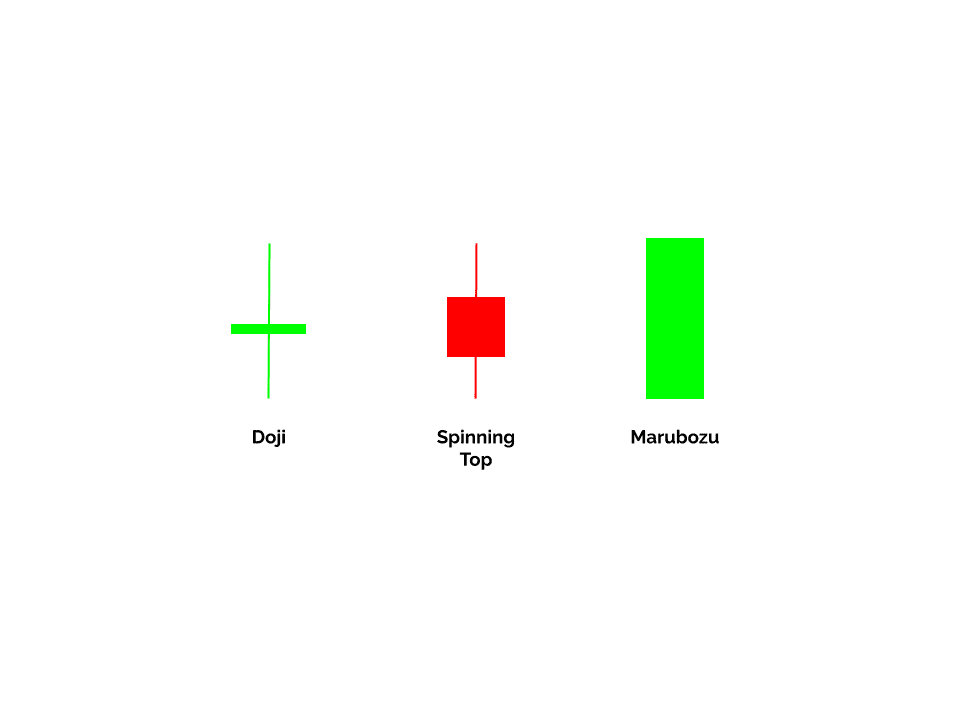
Does Candlestick Pattern Analysis Really Work?
By themselves, these patterns provide the possibility of an impending reversal. Confirm your analysis with other technical analysis tools and techniques to use candlestick analysis effectively.
Combining techniques increases the likelihood that your analysis is correct and is essential before entering a trade.
For confirmation, you must use other tools such as Trend, Momentum, Chart Patterns, and Support and Resistance, or you will likely find trading with Japanese Candlesticks disappointing and unprofitable.
Is Trading Japanese Candles Different for Forex Trading than for Stocks/ETFs?
Foreign exchange candlesticks are a popular and valuable tool for trading forex; however, they differ when trading stock/exchange-traded funds (ETF) in one significant way.
You may have noticed that forex candlesticks rarely have gaps since the market operates 24 hours a day, five days a week.
In contrast, stock/ETF patterns have more price gaps because they open and close five days per week, and the opening is influenced by pre-market action.
As a result, some patterns are valid, but you will need an interpretation specific to the market in which they operate.
You Must Take Special Note of Long Shadows
Occasionally you may see a candle with an exceptionally long shadow on a short body. You will notice it because it looks out of place.
Remember that it only takes one trade to make a long shadow, so if you see a candle looking odd, reduce your time frame and figure out when it occurred.
Most likely, it’s an aberration and doesn’t represent true market sentiment.
I recommend not including a strange long shadow in your candlestick chart pattern reading. An example of a candle pattern where this occurs is a Dragonfly Doji, as seen below. This is a legitimate pattern, but the tail is subject to “long shadow problems.”
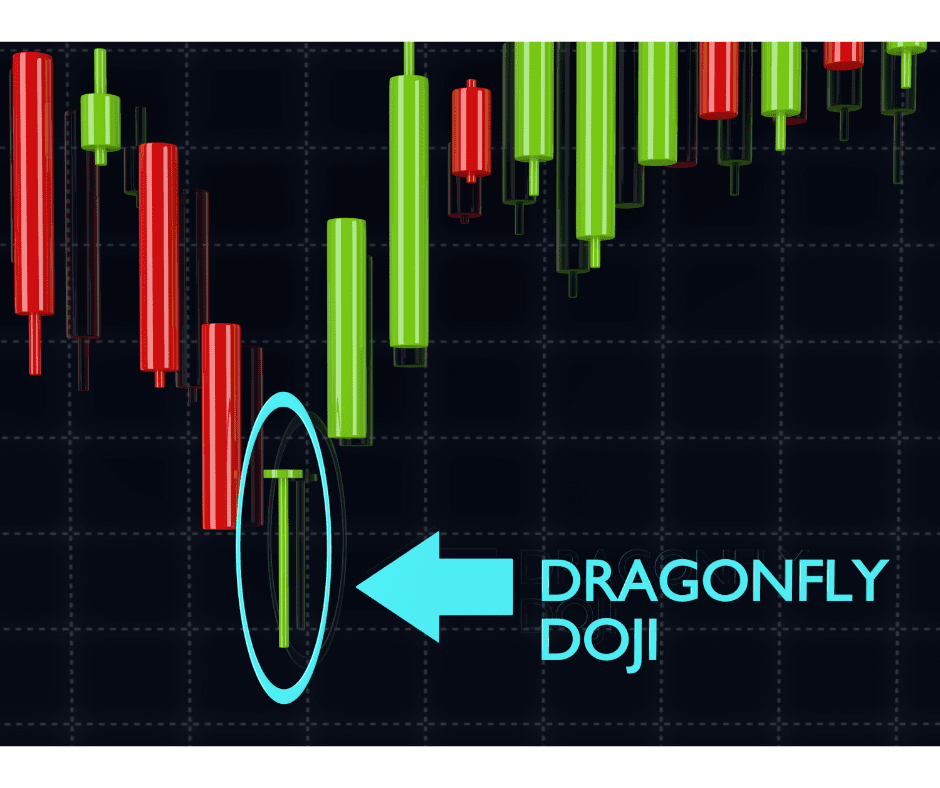
Know the Three Candlestick Pattern Families
There are a variety of candlestick patterns, such as one-candle, two-candle, and three-candle patterns. Although each pattern has its own unique features and characteristics, they all share specific common attributes.
- One-candle Japanese Candlestick patterns consist of a single candlestick. The body often consists of a small body and a long shadow. The frequently found one-candle patterns include Hammer, Shooting Star, Hanging Man, Inverted Hammer, and more.
- Two-candle Japanese Candlestick patterns consist of two candlesticks that alternate in the opening and closing positions. As the name suggests, these patterns consist of two price points with bodies that connect them. Examples of these patterns include Engulfing, Dark Cloud Cover, Piercing, and more. These are the most frequently used and most popular candlestick patterns.
- Three-candle Japanese Candlestick patterns are similar to two-candle patterns but have three price points instead of two. Commonly found or Morning Star, Evening Star, Three Inside, and many others.
You will want to familiarize yourself with various patterns to find reversal opportunities.
There is an almost endless list of patterns, but focusing on the most popular patterns will yield the best results.
Examples of one-candle, two-candle, and three-candle patterns are below.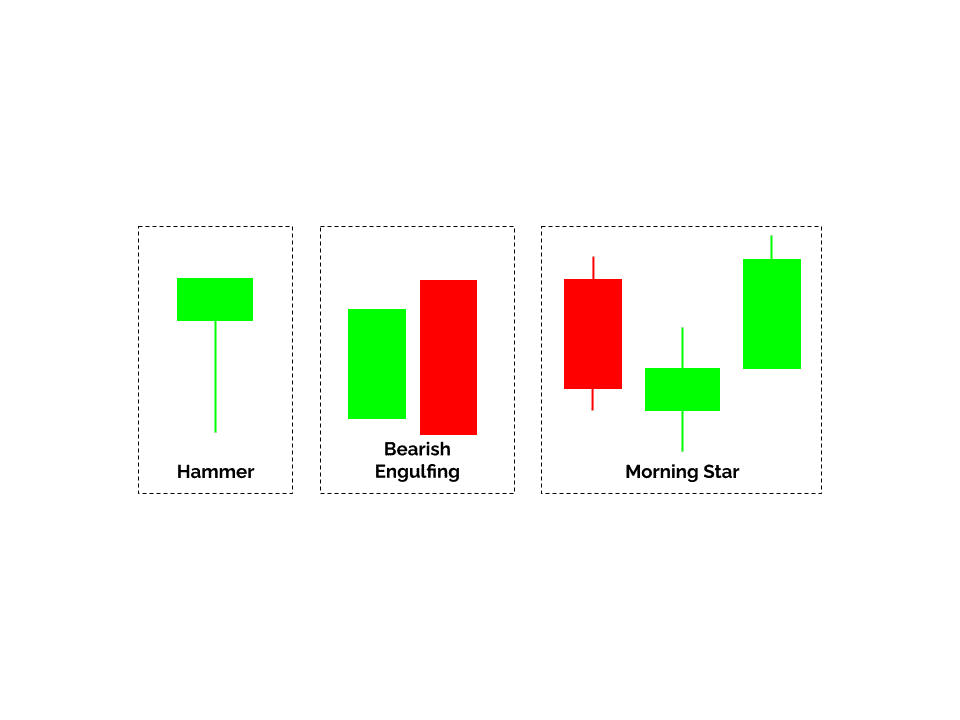
Hammer and Hanging Man
The Hammer pattern is a Bullish candle reversal pattern you will find at the end of Selloffs.
The Hanging Man has the same physical characteristics as the Hammer pattern, but you will find it at the end of Rallies, causing a Bearish reversal.
Hammer candlesticks have a small body and a long lower shadow, while Hanging Man candlesticks have a small body and a long upper shadow.
Ideally, Hammers would be Bullish (green candle in color) and the Hanging Man Bearish (red candle in color), but that isn’t required.
You must judge whether the Bullish signal with the Bearish candle affects your belief in the pattern.
The psychology behind each candle is the same. An instrument’s prices have exceeded most market participants’ expectations and have shrunk away from its extreme.
This single candle pattern can result in enormous changes in price over time in either direction.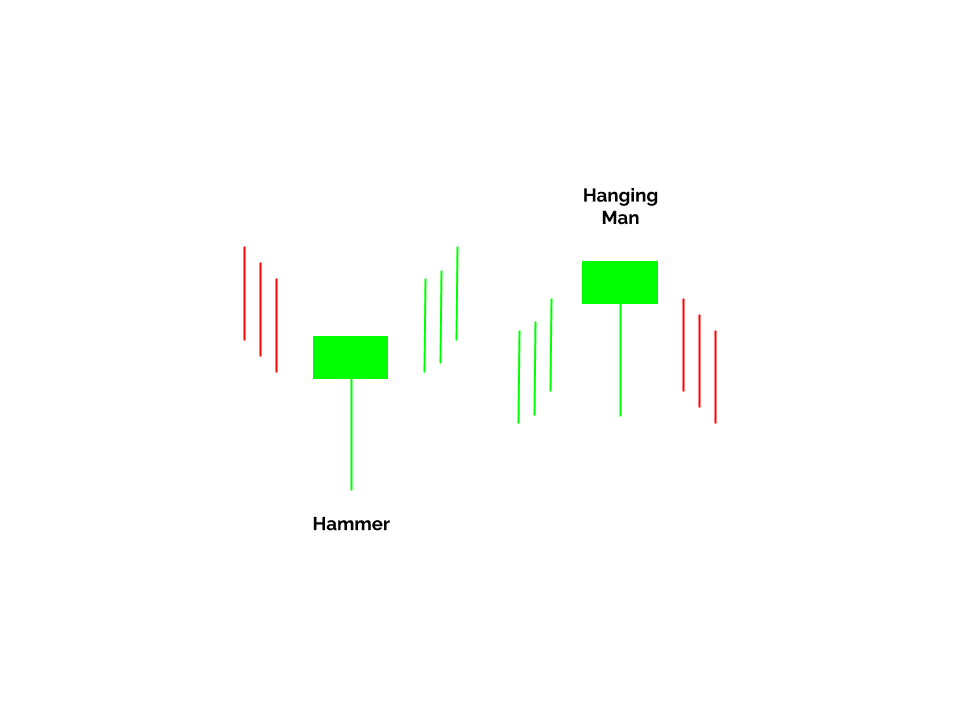
Bullish Engulfing and Bearish Engulfing
The Bullish Engulfing and Bearish Engulfing Patterns are two candle patterns where the second candle “engulfs” the previous one with a broader open and close.
The psychology of the pattern is the market gave up the prior direction and, with enthusiasm, reversed the preceding session’s direction.
Engulfing patterns are powerful signals depicting strong market opinion, especially when the candles are substantial in size. The Bullish Engulfing pattern reverses a Selloff, whereas a Bearish Engulfing pattern ends a Rally.
The Bearish Engulfing pattern is found below 0.6500 Support and Resistance and needs Trend confirmation and Momentum support.
The LSMA was in a Bearish Trend, and Momentum was Neutral after the countertrend before the Bearish Engulfing failed to materialize.
Using 0.6500 as a Stop and 0.5700 as a Target, this trade provided an attractive 1:2.5 risk-reward ratio.
After a 4.18% gain in a week of 247 pips, I recommend you take profits off the table.
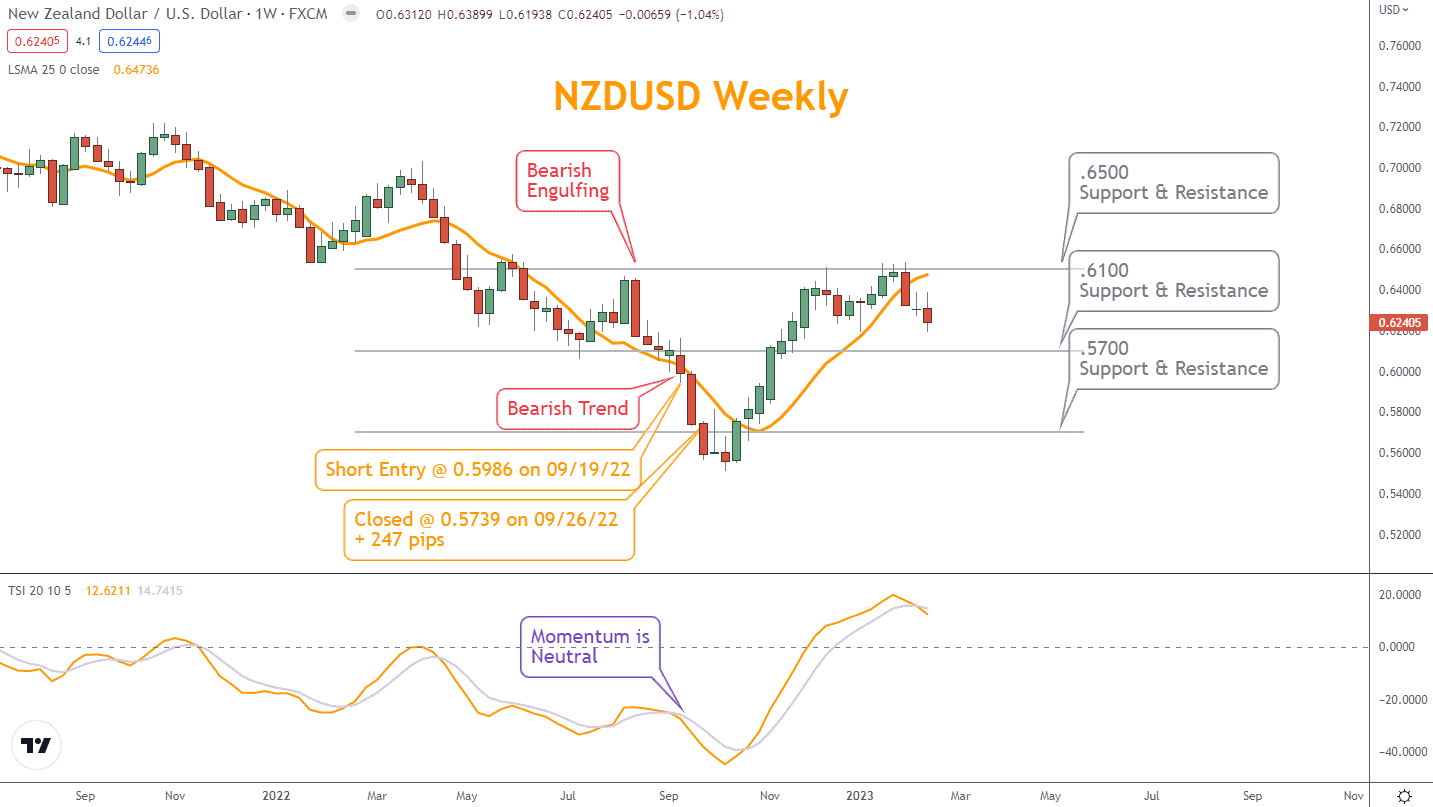
Morning Star and Evening Star
This pattern is a sign of hope in a bleak market Selloff and consists of three candlesticks, with the first long red candlestick followed by a short-bodied candle and a long green candlestick.
The pattern breaks down as follows:
- The first candlestick in a Morning Star pattern has a large body with prices closing lower.
- The second is a pint-sized body compared to the first candlestick indicating that prices fell below the opening price, but conviction dissipated.
- The third candlestick in the pattern is long and moves the instrument’s price by more than 50% into the first candle’s body.
The Evening Star candlestick pattern occurs at the top of a Rally and consists of three candlesticks like the Morning Star but in the opposite direction.
In general multi-candle reversal patterns are more reliable than single-candle reversals, but all of them can be traded successfully when combined with other technical analysis tools and techniques.
The Morning Star candlestick pattern is a sign of hope in a bleak market Selloff and consists of three candlesticks, with the first long red candlestick followed by a short-bodied candle and a long green candlestick.
- The first candlestick in a Morning Star pattern has a large body with prices closing lower.
- The second is a very small body compared to the first candlestick indicating that prices fell below the opening price, but conviction dissipated.
- The third candlestick in the pattern is long and moves the instrument’s price by more than 50% into the first candle’s body.
The Evening Star candlestick pattern occurs at the top of a Rally and consists of three candlesticks like the Morning Star but in the opposite direction.
In general multi-candle reversal patterns are more reliable than single-candle reversals, but all of them can be traded successfully when combined with other technical analysis tools and techniques.
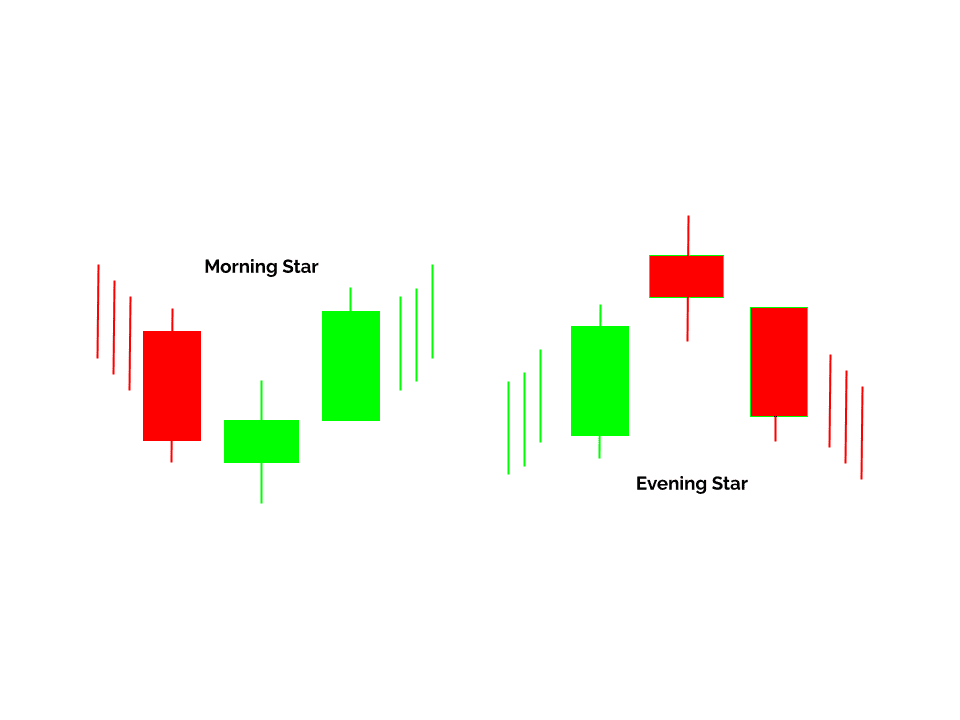
What are your Next Steps?
Using what you’ve learned, select a chart and look for Japanese Chart pattern reversals. In addition, look for opportunities to coincide them with other technical analysis tools and techniques to see how they work together.
Here is an example of a Japanese Candlestick reversal with other technical analyses using our Six Basics of Chart Analysis. If you’re unfamiliar with the Six Basics, you can learn them here for free.
The “Six Basics” will give you a strong foundation in chart analysis which you can incorporate with what you’ve learned here about position sizing.
In addition, when you get the “Six Basics,” you’ll also get Forex Forecast delivered to your inbox every Sunday.
Forex Forecast includes:
- Trade Ideas and Analysis
- Using the Six Basics of Chart Analysis and Advanced Strategies, I show you the trade opportunities I’m watching.
- Case Studies from Around the Web
- Watch how applying the Six Basics worked on some of the best, most profitable trades.
- Trading Education Guides and Videos
- Want to learn most Six Basics techniques and Advance Strategies? I produce Videos and Guides to help you learn and build a better trading practice.
- Links to New Articles
- I publish new articles on topics traders will want to know about every week, and you can find out when they post.
- Positionforex.com News
- Did something change at positionforex.com? Learn about it here first!
- Links to upcoming webinars
- Attend free webinars to improve your trading.
- And Much More
- Tools, Membership-only Videos, and more will be released in the Forex Forecast.
The best part – it’s completely free.
Additional practice can be had by opening a demo account with a forex broker and practicing. You can then open a live account when you have a comfort level.
Frequently Asked Questions
Which Candlestick Pattern is Best for Trading?
In combination with technical analysis, different candlestick patterns can be used to identify opportunities. When used correctly and in context with technical analysis tools and techniques, candlestick patterns can be profitable for traders.
Can I use Candlesticks in all Timeframes or Specific Timeframes only?
Candlestick patterns do work on any timeframe; however, the longer the time frame, the greater the confidence a trader can have in the pattern since there is more market participation. The same is true for other technical analysis tools and techniques too.
Day trading or swing trading with Candlestick Patterns often requires multiple timeframes, creating a new set of challenges.


